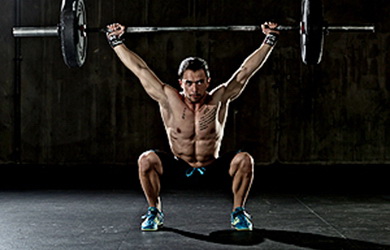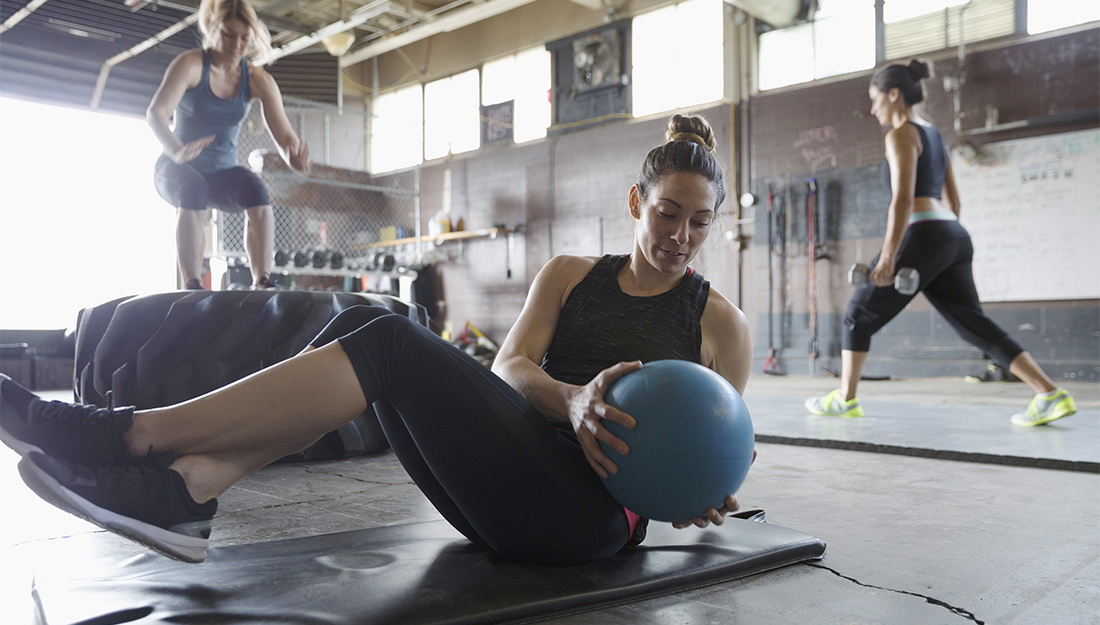
Ask A Pro, Get Answers | CrossFit
Ask A Pro, Get Answers
CrossFit

Q:
Is CrossFit good for you?
A:
Unfortunately some critics say that CrossFit is the cause of many injuries and, ultimately, is dangerous. There is no evidence to support this mistaken belief. Injuries can happen anywhere, while playing any sport, and at any fitness level. Injuries are caused by poor technique, muscular imbalance, overuse, lack of recovery and poor coaching, all of which are NOT the fault of CrossFit as a sport.
With any sport, or in any aspect of life, it is important to progress safely and slowly. Stay healthy when doing CrossFit with these three easy steps:
1. START WITH THE BASICS.
It is essential that you take the time to master the fundamental movements involved in CrossFit before increasing weight/load. There is a learning curve involved with every sport that must be overcome to help prevent future injuries. Personal training is offered at most CrossFit affiliates and is a great way to learn, gain confidence and build a strong foundation before joining classes.
2. WARM UP and COOL DOWN.
This is the time for you to address any specific areas of your body that need more attention. Be sure to hydrate before and after class!
A warm up should include:
Light biking, rowing or running to increase blood flow to your working muscles (5-10 mins).
Dynamic stretching and/or foam rolling to decrease tension in muscle tissue and enhance mobility.
Activation exercises to prepare the body and enhance the connection/pathways between the brain and muscles. The main areas to address are core, glutes and postural muscles but, yet again, this will vary from one individual to the next.
A cool down should include:
Light biking or walking to decrease body temperature and to aid in waste removal from muscles (5-10 mins)
Static stretching to help restore and relax muscles.
3. GET ASSESSED.
Athletic Therapists, alongside other health care professionals, can provide excellent support and advice to help you reach your CrossFit goals. We take pride in helping individuals to decrease their pain and increase function. Specific exercises tailored to your body’s needs and/or dysfunction can be an excellent complement to the movements involved in CrossFit.
Jonathan Sun BPE, CAT(C)
Certified Athletic Therapist
Ask A Pro, Get Answers
CrossFit

Q:
Is CrossFit good for you?
A:
Unfortunately some critics say that CrossFit is the cause of many injuries and, ultimately, is dangerous. There is no evidence to support this mistaken belief. Injuries can happen anywhere, while playing any sport, and at any fitness level. Injuries are caused by poor technique, muscular imbalance, overuse, lack of recovery and poor coaching, all of which are NOT the fault of CrossFit as a sport.
With any sport, or in any aspect of life, it is important to progress safely and slowly. Stay healthy when doing CrossFit with these three easy steps:
1. START WITH THE BASICS.
It is essential that you take the time to master the fundamental movements involved in CrossFit before increasing weight/load. There is a learning curve involved with every sport that must be overcome to help prevent future injuries. Personal training is offered at most CrossFit affiliates and is a great way to learn, gain confidence and build a strong foundation before joining classes.
2. WARM UP and COOL DOWN.
This is the time for you to address any specific areas of your body that need more attention. Be sure to hydrate before and after class!
A warm up should include:
Light biking, rowing or running to increase blood flow to your working muscles (5-10 mins).
Dynamic stretching and/or foam rolling to decrease tension in muscle tissue and enhance mobility.
Activation exercises to prepare the body and enhance the connection/pathways between the brain and muscles. The main areas to address are core, glutes and postural muscles but, yet again, this will vary from one individual to the next.
A cool down should include:
Light biking or walking to decrease body temperature and to aid in waste removal from muscles (5-10 mins)
Static stretching to help restore and relax muscles.
3. GET ASSESSED.
Athletic Therapists, alongside other health care professionals, can provide excellent support and advice to help you reach your CrossFit goals. We take pride in helping individuals to decrease their pain and increase function. Specific exercises tailored to your body’s needs and/or dysfunction can be an excellent complement to the movements involved in CrossFit.
Jonathan Sun BPE, CAT(C)
Certified Athletic Therapist
Ask A Pro, Get Answers
CrossFit

Q:
Is CrossFit good for you?
A:
Unfortunately some critics say that CrossFit is the cause of many injuries and, ultimately, is dangerous. There is no evidence to support this mistaken belief. Injuries can happen anywhere, while playing any sport, and at any fitness level. Injuries are caused by poor technique, muscular imbalance, overuse, lack of recovery and poor coaching, all of which are NOT the fault of CrossFit as a sport.
With any sport, or in any aspect of life, it is important to progress safely and slowly. Stay healthy when doing CrossFit with these three easy steps:
1. START WITH THE BASICS.
It is essential that you take the time to master the fundamental movements involved in CrossFit before increasing weight/load. There is a learning curve involved with every sport that must be overcome to help prevent future injuries. Personal training is offered at most CrossFit affiliates and is a great way to learn, gain confidence and build a strong foundation before joining classes.
2. WARM UP and COOL DOWN.
This is the time for you to address any specific areas of your body that need more attention. Be sure to hydrate before and after class!
A warm up should include:
Light biking, rowing or running to increase blood flow to your working muscles (5-10 mins).
Dynamic stretching and/or foam rolling to decrease tension in muscle tissue and enhance mobility.
Activation exercises to prepare the body and enhance the connection/pathways between the brain and muscles. The main areas to address are core, glutes and postural muscles but, yet again, this will vary from one individual to the next.
A cool down should include:
Light biking or walking to decrease body temperature and to aid in waste removal from muscles (5-10 mins)
Static stretching to help restore and relax muscles.
3. GET ASSESSED.
Athletic Therapists, alongside other health care professionals, can provide excellent support and advice to help you reach your CrossFit goals. We take pride in helping individuals to decrease their pain and increase function. Specific exercises tailored to your body’s needs and/or dysfunction can be an excellent complement to the movements involved in CrossFit.
Jonathan Sun BPE, CAT(C)
Certified Athletic Therapist
Ask A Pro, Get Answers
CrossFit

Q:
Is CrossFit good for you?
A:
Unfortunately some critics say that CrossFit is the cause of many injuries and, ultimately, is dangerous. There is no evidence to support this mistaken belief. Injuries can happen anywhere, while playing any sport, and at any fitness level. Injuries are caused by poor technique, muscular imbalance, overuse, lack of recovery and poor coaching, all of which are NOT the fault of CrossFit as a sport.
With any sport, or in any aspect of life, it is important to progress safely and slowly. Stay healthy when doing CrossFit with these three easy steps:
1. START WITH THE BASICS.
It is essential that you take the time to master the fundamental movements involved in CrossFit before increasing weight/load. There is a learning curve involved with every sport that must be overcome to help prevent future injuries. Personal training is offered at most CrossFit affiliates and is a great way to learn, gain confidence and build a strong foundation before joining classes.
2. WARM UP and COOL DOWN.
This is the time for you to address any specific areas of your body that need more attention. Be sure to hydrate before and after class!
A warm up should include:
Light biking, rowing or running to increase blood flow to your working muscles (5-10 mins).
Dynamic stretching and/or foam rolling to decrease tension in muscle tissue and enhance mobility.
Activation exercises to prepare the body and enhance the connection/pathways between the brain and muscles. The main areas to address are core, glutes and postural muscles but, yet again, this will vary from one individual to the next.
A cool down should include:
Light biking or walking to decrease body temperature and to aid in waste removal from muscles (5-10 mins)
Static stretching to help restore and relax muscles.
3. GET ASSESSED.
Athletic Therapists, alongside other health care professionals, can provide excellent support and advice to help you reach your CrossFit goals. We take pride in helping individuals to decrease their pain and increase function. Specific exercises tailored to your body’s needs and/or dysfunction can be an excellent complement to the movements involved in CrossFit.
Jonathan Sun BPE, CAT(C)
Certified Athletic Therapist
© Copyright Evolution Sport Therapy 2022.
Newsletter Signup
Sign up for our newsletter to receive all the latest!
Newsletter Signup
Sign up for our newsletter to receive all the latest!
© Copyright Evolution Sport Therapy 2022.
Newsletter Signup
Sign up for our newsletter to receive all the latest!
© Copyright Evolution Sport Therapy 2022.